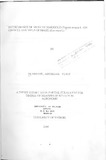Interference of Mexican Marlgold (tagetes minuta l) on growth and yield of maize (zea mays l)
Abstract
Damage caused by weeds and the cost of their control constitute one
of the largest losses in production of feed, food and fiber. This study
was conducted to determine whether application of recommeded
fertilizer rate influence the critical period of competition between
Tagetes minuta and maize. Inter and intraspecific competition
between the weed and the crop was determined in potted green
house, replacement series experiments.
The period when competition begins in the field was determined by
allowing the weed to grow from crop emergence for varying lengths
of time and then kept weed -free till harvesting. Length of required
weed-free period for maximum yield was determined by keeping
the crop weed-free for varying periods after emergence and then
permiting weed growth the rest of the season. Both the weed and
crop parameters were measured. The experiment was conducted at
the University of Nairobi, Kabete Campus Field Station, on reddish
brown Humic Nitosol.
In greenhouse experiments increasing maize proportion in pots
caused significant reduction in all growth and yield parameters.
Plant relative yield (PRY) of maize was less than one under
fertilization and no fertilization and decreased as the proportion of
T minuta increased in pots, indicating that maize was more affected
by interspecific than intraspecific competition.
A mixture of maize and T.minuta significantly depressed plant
height, irrespective of the proportion of the crop and the weed,
below that of a single maize or T minuta plant per pot at both
fertilization levels(fertilizer and no fertilizer). Also other parameters
such as total, root, stem, and leaf dry weight ratios followed the
same trend. The differences in the amount of total dry matter
production in experiments(l and2) 'were attributed to differences in
leaf area, leave area duration of the canopy and the total amount of solar
radiation intercepted. As planting proportion increased the LA was decreased
due to competition. All other parameters such as specific leaf
weight, leaf area ratio, crop growth rate, relative growth rate and net assimilation
rate followed the same trend.
In field experiments maintaining maize free of T minuta for the first 30
days of growth during 1996 resulted in significant increase in grain yield
relative to full season interference ( P=0.05) at both recommended and zero
fertilization. In zero fertilizer application T minuta interference for 50 days
or more significantly reduced grain yields. Weed dry matter yields were
generally higher in 1996 than 1997.
Linear regression predicted a significant maize yield increase of 160 Kg/ha
and non-significant yield increase of Q.48 Kg/ha for each week of T minuta
weed - free maintenance in 1996 and 1997 respectively. Linear regression
predicted significant maize yield reduction of 252.2 Kg/ha and non-significant
yield reduction of 40 Kg/ha for each week of T minuta interference in
interference in maize with zero fertilizer application was found to be within
the 50 days after planting. Uncontrolled Mexican marigold population
decreased maize grain yields by 59 and 38% during 1996 and 1997
respectively. On the other hand, under recommended fertilizer application
T minuta interference for 60 days or more significantly reduced grain
yield Also weed dry matter yields were generally higher in 1996 than in
1997. No significantly yield increases or reductions were obtained in
weed-free or weed-interference treatments respectively.
Linear regression predicted a significant maize yield increase of 1J 5 and
109.5 Kg/ha for each week of T minuta weed -free maintenance in 1996
and 1997 respectively. Linear regression predicted a significant maize yield
reduction of 152 Kg/ha and non-significant yield reduction of 51.1 Kg/ha
for each week of T minuta interference in 1996 and 1997 respectively.
The critical period of T minuta interference in maize with fertilizer
application was found to be within the first 60 days after planting.
Uncontrolled Trninuta populations decreased maize grain yield by 38 and
47% during 1996 and 1997 respectively.
Maize plants were found to be more competitive during early stages
of growth than the weed. Also this studies indicated that application
of recommended fertilizer rates reduces competition between
Tminuta and maize.
Citation
Warsame, A. Y(2000).Interference of :Mexican Marlgold (tagetes minuta l) on growth and yield of maize (zea mays l)Sponsorhip
University of NairobiPublisher
Department of Plant Science and Crop Protection, University of Nairobi
Description
Msc - Thesis

